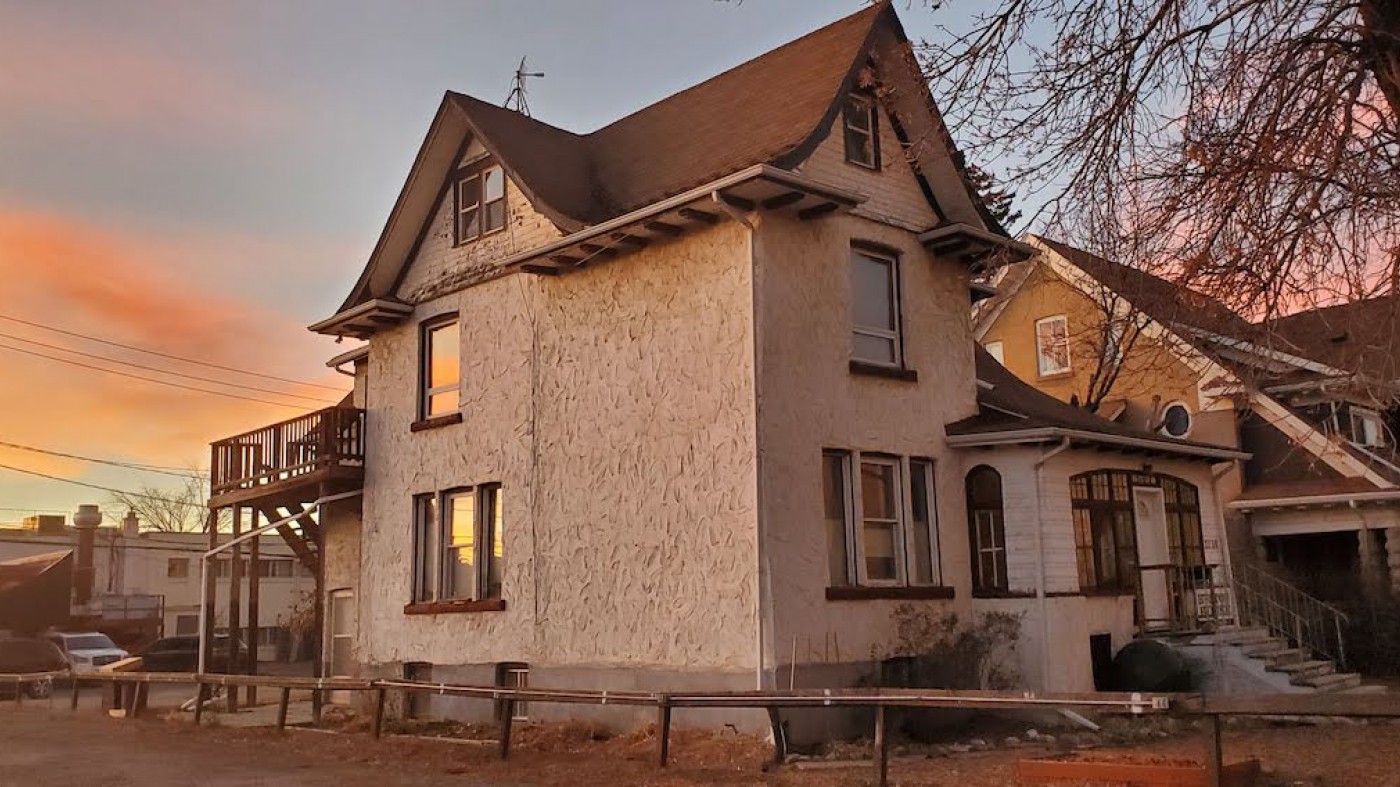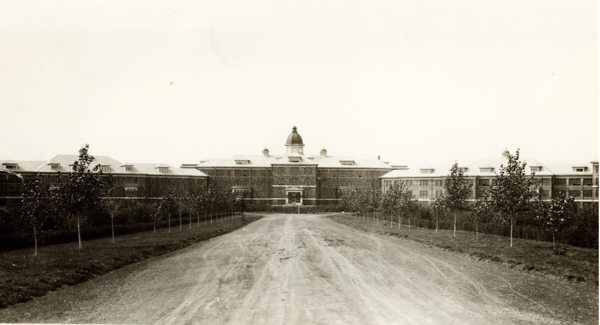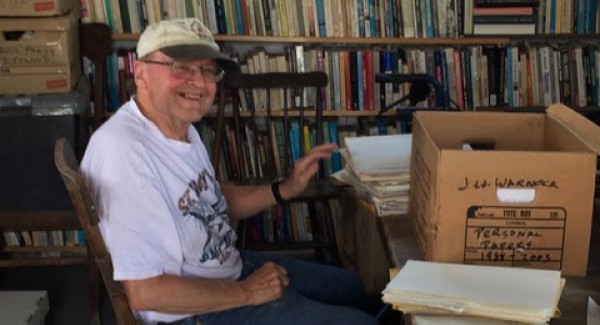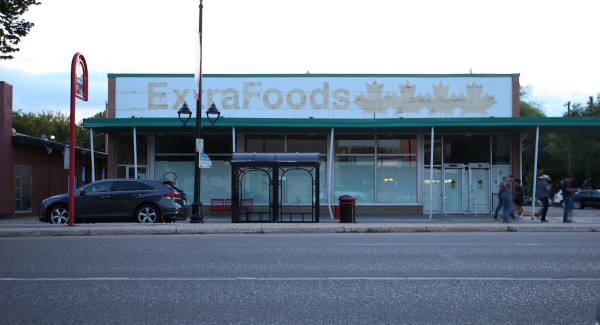Huston House: A history

Huston House in 2021. Photo by Saima Desai.
An unassuming three-storey house sits on the 2100 block of McIntyre Street in Regina. With its white stucco, burgundy trim, and large front porch, it looks like other heritage homes in the area. Nothing but the sign in front of the building, which reads “Huston House,” would indicate that it has been a hub for community activism and grassroots organizing in Saskatchewan for nearly 50 years.
Huston House is a building that provides affordable office space to non-profit organizations in Regina. It is owned and operated by the Edna Curren Memorial Fund (ECMF), itself a non-profit dedicated to supporting international development and educational initiatives in Saskatchewan.
The struggles that have shaped Regina and Saskatchewan over the past half century – fights against uranium mining in the province’s north, against privatization and austerity, for public and active transit, for workers’ rights, and more – have happened under Huston House’s roof. Quietly, the house has been the unofficial headquarters of progressive change in the city.
Origins of the ECMF
The 1960s and ’70s saw the growth of the international development and education movement in Saskatchewan. Several key organizations got their start during this time, including the Saskatchewan Council for International Cooperation (SCIC), One Sky (based in Saskatoon), and the Regina Committee for World Development (RCWD, later renamed Common Cause). All shared similar goals: first, to fund and promote overseas development projects run by Saskatchewan organizations; and second, to help inform the Saskatchewan public about international development, particularly the imbalanced relationship between wealthy and impoverished countries.
These organizations began meeting regularly in 1976, identifying a common need for a support structure. Staff at the non-profits worried about their long-term job security, as their organizations relied largely on precarious funding sources like government grants in order to pay salaries. It was out of these conversations that the ECMF was born.
ECMF’s namesake, Edna Curren, was a farmer from northwestern Saskatchewan and member of the province’s international development movement in the 1970s. She was involved with development education activities through One Sky, the National Farmers Union, and the United Church of Canada. In 1974, she was selected by SCIC to represent Canada’s non-profit organizations at the Special General Assembly of the United Nations on the New International Economic Order in New York. Curren was killed in a car accident in 1976, just before SCIC, One Sky, and RCWD began planning their joint support organization. She was a familiar face to many in these circles and, with the permission of her family, it was agreed that the new organization would be named in her honour.
“Over the years it’s supported so many efforts and struggles and organizations and people doing good work for global justice.”
One of the main problems ECMF identified early on was the difficulty of finding stable meeting and office space for the two member organizations – SCIC and RCWD – that were based in Regina. The search began for a suitable space in Regina. Within three months of ECMF’s incorporation in May 1977, 2138 McIntyre Street was found and bought for $57,000. With a location secured, it was time for the real work to begin.
According to the City of Regina, the house was built in 1911 by contractor James Bartleman and features a “large veranda at the northeast corner […] flared eaves and gables and the decorative application of shingles, bargeboard and modillions.” It’s been on the Regina heritage holding bylaw list since 1989.
They named the house after Harold Huston, the first president of the ECMF. He was known for his tireless devotion to international development work and to the ECMF, going as far as to use his term deposit as security on Huston House when it was first purchased. In tragic parallel to Edna Curren, Huston died in a car accident in August 1977 on his way to a meeting in La Ronge. An “immediate and unanimous” decision was made to name the newly acquired building in his honour. A plaque on the ground floor reads:
Dedicated to the Memory of Harold Huston
His Deep concern
For the Disadvantaged
His Hope and Struggle
For a Just Society
Shall be an Inspiration
For the Activities
of this Place
Huston House today
The first organizations to move into Huston House were the SCIC and the RCWD. Over the years, Huston House has been home to a variety of progressive non-profit and community organizations including Canadian University Services Overseas (now Cuso International), the Regina Open Door Society, Regina Group for a Non-Nuclear Society and its associated publishing house, CUPE Saskatchewan, the Saskatchewan Coalition for Peace and Development, the Regina Green Party, Tools for Peace, the Saskatchewan Linkage Committee, the Regina Coalition for Social Justice, the Youth Fund for Social Solidarity, the Canadian Centre for Policy Alternatives’ Saskatchewan office, Bike Regina and, of course, Briarpatch Magazine. Huston House has additionally served as a mail drop location for the Saskatchewan Ecology Alliance, the International Uranium Congress, the South African Solidarity Committee, the Palestine Support Committee, and several environmental groups.
The rent has always been cheap; Briarpatch, which rents two rooms on the second floor of the house, pays just $450 per month. Staff have joked that the only thing stopping them from living in the attic was Huston House’s lack of a shower. Without that affordable rent, Briarpatch may not have survived its many financial crises. It’s largely thanks to the founders of Huston House that the magazine lives to celebrate its 50th anniversary.
Denise MacDonald has been involved with Huston House for nearly 20 years. Now the network coordinator for SCIC, she was first a volunteer at Huston House and later joined the board of Briarpatch Magazine.
“For me the most important thing [about Huston House] is just how many organizations have gone through there,” MacDonald says. “It’s just a place where organizations can go to be able to do their work [when] they have very few resources. Over the years it’s supported so many efforts and struggles and organizations and people doing good work for global justice.”
“We’d have work bees and garden bees and just [work] together to create something as a community."
Both the fund and the building are overseen by the ECMF’s volunteer board of directors. Employees from HH’s resident organizations – including Briarpatch’s editor and publisher – serve on the ECMF board, although not exclusively. Revenue to support the house comes from the rent that tenants pay and the rental of 10 parking spaces in the property’s backyard.
In the past, the maintenance and renovations on the house were also done almost exclusively by volunteers. Former Briarpatch editor and publisher Andrew Loewen recalls helping with renovations on evenings and weekends while working out of Huston House from 2013 to 2015. One goal of these renovations was to maximize the useable space within the house.
“I remember sanding down the floors or ripping up the carpets and finding hardwood underneath and stuff,” Loewen says. While a certified contractor was brought in to oversee the renovations, “there was definitely [...] maybe a year or more of pretty DIY efforts to remake the space and improve it. We raised the ceiling […] where the main Briarpatch desks are now. We knocked out the ceiling and exposed the brick of the chimney, put in new drywall, renovated the bathroom.”
The community-oriented mindset of Huston House extends beyond its walls and into the property’s green space as well, with staff growing tomatoes, sunflowers, and squash, along with battling creeping bellflower in the front and side yards during the summer.
“One thing that I really enjoyed is when we worked on food production in the yard,” says MacDonald. “We’d have work bees and garden bees and just [work] together to create something as a community. Like I said, there’s been lots of different iterations. But every time it’s been something unique and really special.”
“I think people should know that because of the hard work of visionary people in the 1970s and those who have carried the torch ever since, there’s this paid-off building in downtown Regina that has served, promoted, and support[ed] a lot of great work over the years.”
Stephen Weiss was initially brought on to do a needs assessment of Huston House in 2012. Part of Weiss’s work involved reviewing the history of Huston House and determining what needed to be updated to make sure Huston House can keep housing progressive organizations for years to come. More than a decade later, he’s still involved as an ECMF board member.
During that assessment, “[I and others involved with Huston House] really kind of realized what we had,” he recalls. “When I say that, I mean it’s a pretty good asset to have as a building where rent can be cheap for organizations working toward social justice.”
Weiss’s connection to Huston House is also personal: he lives nearby and has seen its impact from the perspective of a consultant, volunteer, and neighbour.
“It seems like a lot of the things that people talk about – a community hub, an incubator, a co-working [space], all these things – turns out it already existed,” Weiss says. “I think people should know that because of the hard work of visionary people in the 1970s and those who have carried the torch ever since, there’s this paid-off building in downtown Regina that has served, promoted, and support[ed] a lot of great work over the years.”
The house, which was built over 100 years ago, is now showing its age: the stucco on the outside is falling off in chunks, the poor insulation means the overworked boiler gives out a couple of times each winter, and inquisitive animals often like to find refuge in its nooks and crannies. But the ECMF board is hoping to re-insulate the outside of the house – a plan that’s so far been slowed down by the house’s inclusion on the city’s heritage inventory list, which restricts changes to the exterior. Reflecting the politics of its tenants, one goal Weiss cites is to bring the building to net-zero energy emissions.
While it’s impossible to capture the full scope of Huston House’s impact in a single article, the people I spoke to stressed not just the importance of Huston House’s physical space, but also the importance of its people and community.
“There have just been so many amazing people that have worked in those organizations and in that building,” McDonald says. “It’s heartening. You will have an awesome conversation with somebody that you meet there. It feels really good to feel supported and […] be with like-minded people.”




